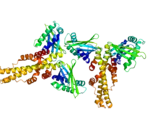Cernunnos deficiency
| Cernunnos deficiency | |
|---|---|
| Other names | Combined immunodeficiency-microcephaly-growth retardation-sensitivity to ionizing radiation syndrome, Cernunnos XLFD |
 | |
| Cernunnos deficiency is inherited via autosomal recession | |
| Symptoms | Microcephaly[1] |
| Causes | NHEJ1 gene mutation[1] |
| Diagnostic method | Clinical features[1] |
| Treatment | Immunoglobulin replacement, HSCT[1] |
Cernunnos deficiency is a form of combined immunodeficiency characterized by microcephaly, due to mutations in the NHEJ1 gene, it is inherited via autosomal recessive manner[2][1] Management for this condition is antiviral prophylaxis and antibiotic treatment
Symptoms and signs
The sign and symptoms of this condition on an affected individual are as follows:[1]
- Recurrent infections
- Microcephaly
- Growth retardation
- Bone-malformation
- Dysmorphic feature
- Urogenital malformations
Cause

In terms of genetics the condition, Cernunnos deficiency is due to a mutation in the NHEJ1 gene, it has a cytogenetic location of 2q35, while its molecular location is 219,075,324 to 219,160,865 [3][2]
Mechanism
The pathophysiology of Cernunnos deficiency begins with normal function of Non-homologous end-joining factor 1 gene. NHEJ1 encodes a protein which helps repair of breaks in double-stranded DNA. It might additionally act as a connection between XRCC4 and other NHEJ factors (at DNA ends)[4][3][5]
When a mutation occurs in NHEJ1, then one sees that nucleotide deletions cause V(D)J recombination, signal joints, to be affected.[6] V(D)J recombination is a genetic recombination that happens in early stages of B and T cell maturation.[7]
Diagnosis

The diagnosis of Cernunnos deficiency will find the following in an affected individual via clinical features and blood test:[6][1]
- B lymphopenia
- T lymphopenia
- Hypogammaglobulinemia with low IgA
- Hypogammaglobulinemia with low IgM
Differencial diagnosis
The DDx for Cernunnos deficiency are both LIG4 syndrome, as well as Nijmegen breakage syndrome[1]
Management
In terms of management for Cernunnos deficiency, one finds that treatment with allogeneic hematopoietic stem cell transplantation, which are stem cells that bring about other cells[8]) has proven useful in some instances. Additionally the following treatments are also used:[9][1]
- Antibiotic treatment
- Immunoglobulin replacement
See also
- Cernunnos
- Combined immunodeficiency
References
- 1 2 3 4 5 6 7 8 9 RESERVED, INSERM US14 -- ALL RIGHTS. "Orphanet: Cernunnos XLF deficiency". www.orpha.net. Retrieved 2017-06-22.
- 1 2 "OMIM Entry - # 611291 - SEVERE COMBINED IMMUNODEFICIENCY WITH MICROCEPHALY, GROWTH RETARDATION, AND SENSITIVITY TO IONIZING RADIATION". omim.org. Retrieved 2017-06-22.
- 1 2 Reference, Genetics Home. "NHEJ1 gene". Genetics Home Reference. Retrieved 2017-06-22.
- ↑ "NHEJ1 non-homologous end joining factor 1 [Homo sapiens (human)] - Gene - NCBI". www.ncbi.nlm.nih.gov. Retrieved 2017-07-13.
- ↑ "OMIM Entry - * 611290 - NONHOMOLOGOUS END-JOINING FACTOR 1; NHEJ1". www.omim.org. Retrieved 2017-07-13.
- 1 2 Rezaei, Nima; Aghamohammadi, Asghar; Notarangelo, Luigi D. (2008-08-06). Primary Immunodeficiency Diseases: Definition, Diagnosis, and Management. Springer Science & Business Media. p. 56. ISBN 9783540789369.
- ↑ Roth, David B.; Antes, JR; Adams, RW; Trumm, GA (December 2014). V(D)J Recombination: Mechanism, Errors, and Fidelity. Microbiology Spectrum. Vol. 2. pp. 313–324. doi:10.1128/microbiolspec.MDNA3-0041-2014. ISBN 9781555819200. ISSN 2165-0497. PMC 5089068. PMID 26104458.
- ↑ "Bone Marrow (Hematopoietic) Stem Cells | stemcells.nih.gov". stemcells.nih.gov. Retrieved 2017-07-13.
- ↑ Sullivan, Kathleen E.; Stiehm, E. Richard (2014-08-08). Stiehm's Immune Deficiencies. Academic Press. p. 122. ISBN 9780124058606.
Further reading
- Ratcliffe, Michael (2016). Encyclopedia of Immunobiology (Vol 1 Development and phylogeny of the immune system ed.). Academic Press. ISBN 9780080921525. Retrieved 13 July 2017.